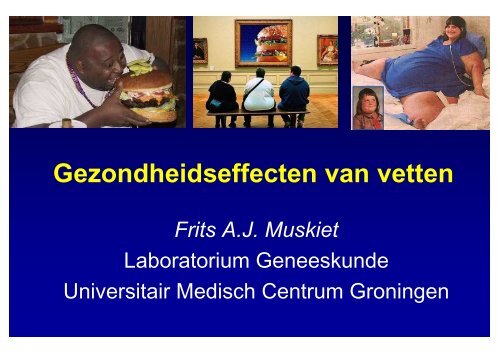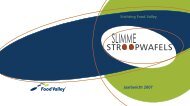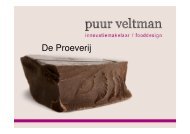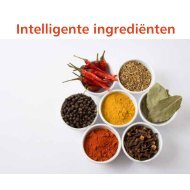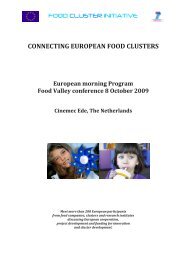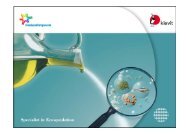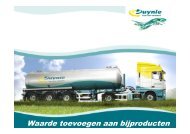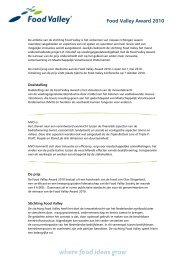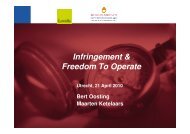Frits Muskiet.pdf - Food Valley
Frits Muskiet.pdf - Food Valley
Frits Muskiet.pdf - Food Valley
You also want an ePaper? Increase the reach of your titles
YUMPU automatically turns print PDFs into web optimized ePapers that Google loves.
Gezondheidseffecten van vetten<br />
<strong>Frits</strong> A.J. <strong>Muskiet</strong><br />
Laboratorium Geneeskunde<br />
Universitair Medisch Centrum Groningen
Ancel Keys<br />
The seven<br />
countries<br />
study; ≥1958
Relation between cholesterol and CAD risk<br />
1=2<br />
1% total cholesterol<br />
reduction =<br />
2% CAD risk reduction
LDL brengt cholesterol<br />
HDL haalt cholesterol
Lipoproteins and CAD risk<br />
Lipoprotein<br />
CAD risk reduction<br />
1% reduction total cholesterol 2%<br />
1% reduction total cholesterol/HDL 1.3%<br />
1% reduction LDL-cholesterol 1.7%<br />
1% increase HDL-cholesterol 3%
De meest gebruikte<br />
risicofactor is de<br />
totaal cholesterol/<br />
HDL cholesterol ratio
Sterfterisico voor patiënten zonder HVZ en zonder DM2 als basis<br />
voor de keuze van behandeling (gebaseerd op de SCORE risicofunctie)<br />
Komende<br />
10 jaar:<br />
CBO, Cardiovasculair<br />
Risicomanagement<br />
2006
Welke<br />
voedingsstoffen<br />
beïnvloeden ons<br />
cholesterol?
Mensink (AJCN 2003): Bij vervanging 1 en% CHO door 1 en% vetzuren
Predicted changes in the ratio of serum total chol/HDL, LDL and<br />
HDL when 1 energy% carbohydrates is isoenergetically<br />
replaced with 12:0, 14:0, 16:0 or 18:0<br />
Mensink, AJCN 2003
De kritiek
Is cholesterol<br />
eigenlijk wel de<br />
oorzaak?
US<br />
English<br />
AB19
Strong relation between LDL-reduction and<br />
CRP-reduction in trials of lipid lowering<br />
O’Keefe, Am J Cardiol 2006
Hoe ligt die relatie<br />
van verzadigd vet<br />
met cholesterol<br />
eigenlijk?
Correlation of dietary saturated fat with total blood cholesterol.<br />
Shaded portion indicated to show expected benefit as SAFA is lowered<br />
Volek, Prog Lipid Res 2008
Changes in serum LDL-cholesterol (and HDLcholesterol)<br />
in response to % change in dietary SAFA.<br />
1 en% SAFA<br />
increase augments<br />
serum LDLcholesterol<br />
by 0.033-<br />
0.045 mmol/L<br />
1 en% SAFA<br />
increase augments<br />
serum HDLcholesterol<br />
by 0.011-<br />
0.013 mmol/L<br />
US DRIs for energy, CHO..2005
De Maasai drinken<br />
veel melk en eten<br />
veel vlees, dus veel<br />
verzadigd vet
Maasai milk is extremely high in palmitic<br />
acid and extremely low in linoleic acid<br />
palmitate<br />
linoleate<br />
Kuipers, PLEFA 2007
Maasai<br />
Anthropometry: 172 cm, 57.8 kg;<br />
BMI 19.6 kg/m 2<br />
Diet: Fermented milk and meat:<br />
high in SAFA and cholesterol<br />
Physical fitness: exceptionally high<br />
Total cholesterol: mean 3.2 ; rarely<br />
>3.8 mmol/L;<br />
Conditions: little evidence of CAD,<br />
high blood pressure unusual<br />
Mann, Am J Epidemiol 1972
Hoe zit het eigenlijk<br />
met die<br />
koolhydraten?
Predicted changes in total chol/HDL when mixed fat constituting 10% of<br />
energy in the "average" US diet is isoenergetically replaced with a<br />
particular fat or with carbohydrates<br />
Mensink, AJCN 2003
Is dat verzadigd vet<br />
wel de enige oorzaak<br />
of werkt het<br />
misschien samen met<br />
die koolhydraten?
Forsyt/Volek study<br />
- 40 overweight men and women (18-55 y) with atherogenic dyslipidemia<br />
ad libitum 12 weeks:<br />
- very low carbohydrate (VLCKD) (1504 kcal:%CHO:fat:protein = 12:59:28)<br />
- low fat (LFD) (1478 kcal:%CHO:fat:protein = 56:24:20)<br />
Forsyte, Lipids 2008
Het hoog-vet dieet leverde meer SAFA<br />
dan het hoog-koolhydraat dieet<br />
Forsyte, Lipids 2008
Toch hadden de personen met het hoog-koolhydraat<br />
dieet de hoogste hoeveelheid SAFA in hun bloed<br />
Forsyte, Lipids 2008
Changes in subjects consuming a very low-carbohydrate<br />
ketogenic diet (VLCKD) or a low-fat diet (LFD) for 12 weeks:<br />
VLCKD better than LFD<br />
Volek, Prog Lipid Res 2008
Het CRD dieet had anti-inflammatoire effecten
Wat er gebeurt is dat bij een<br />
hoog koolhydraat dieet SAFA<br />
worden gemaakt en dat de<br />
voedings SAFA worden<br />
gespaard; deze ophopende<br />
SAFA leiden tot een<br />
inflammatoire reactie
Recente meta-analyse SAFA<br />
5-23 jaar follow-up 347.747 personen<br />
Siro-Tarino, Krauss, AJCN 2010
Recente meta-analyse inzake<br />
melk producten<br />
German, Krauss, J Nutr 2009
NRC, 30 januari 2010<br />
Niettus!<br />
Wellus!
Lifestyle triggers of<br />
chronic systemic low grade inflammation<br />
Diet<br />
↑ω6/ω3 ratio<br />
↑SAFA at ↑CHO<br />
↑trans FA<br />
↓vitamin D<br />
↓vitamin K<br />
antioxidant<br />
disbalance<br />
↑high GI CHO,<br />
↑Sucrose,<br />
↑HFCS<br />
Obesity<br />
per se?<br />
Stress<br />
Inflammation<br />
↑Inadequate<br />
sleep<br />
↑Pollution<br />
Smoking<br />
Fine dust<br />
Others<br />
Gut and dental<br />
bacteria<br />
Hotamisligil Nat Med 2008<br />
↓Physical<br />
activity
Conclusies<br />
Dat verzadigd vet verhaal valt wel wat mee en is niet de<br />
belangrijkste factor in ons hoog cholesterol<br />
Het ene verzadigd vet is het andere niet<br />
De koolhydraten, vooral de “snelle”, zijn meer verdacht<br />
Verzadigd vet samen met hoog koolhydraat is geen goed idee<br />
Het mechanisme is waarschijnlijk door het ontstaan van een<br />
ontstekingsreactie<br />
Koolhydraat en verzadigd vet zijn niet de enige<br />
voedingsstoffen die een ontstekingsreactie veroorzaken<br />
We moeten terug naar de voedingssamenstelling van de<br />
jager-verzamelaars (>10.000 jaar geleden)
The end
All fatty acids with a double bond in the trans configuration<br />
raise the ratio of plasma LDL to HDL cholesterol<br />
“All” raise LDL<br />
“All” lower HDL<br />
Elimination of 0.5 en% =<br />
1.5-6 % CAD reduction<br />
39 studies: 29 treatments with industrial trans<br />
fatty acids, 6 with ruminant trans fatty acids and<br />
17 with CLA.<br />
Brouwer, Wanders, Katan, PloS One 2010
All fatty acids with a double bond in the trans configuration<br />
raise the ratio of plasma LDL to HDL cholesterol<br />
“All” raise LDL<br />
“All” lower HDL<br />
??<br />
??<br />
Elimination of 0.5 en% =<br />
1.5-6 % CAD reduction<br />
39 studies: 29 treatments with industrial trans<br />
fatty acids, 6 with ruminant trans fatty acids and<br />
17 with CLA.<br />
Brouwer, Wanders, Katan, PloS One 2010
Scenarios trans fatty acid reduction/elimination<br />
from 2.1 to 1.1 en%<br />
6% CAD<br />
reduction<br />
from 2.1 to 0.1 en%<br />
23% CAD<br />
reduction<br />
Mozaffarian, NEJM 2006


